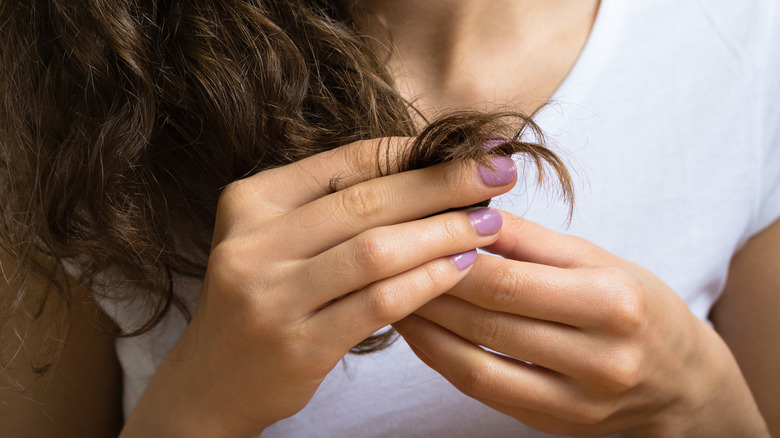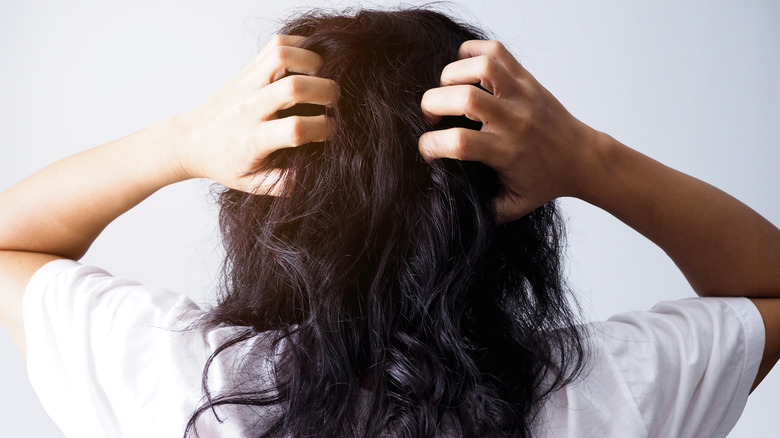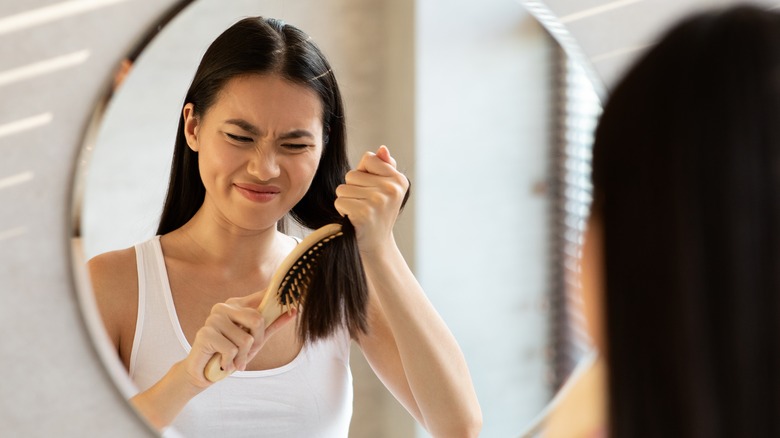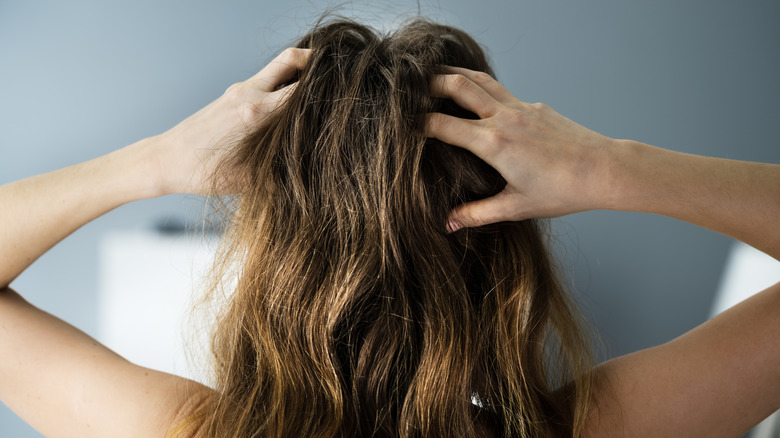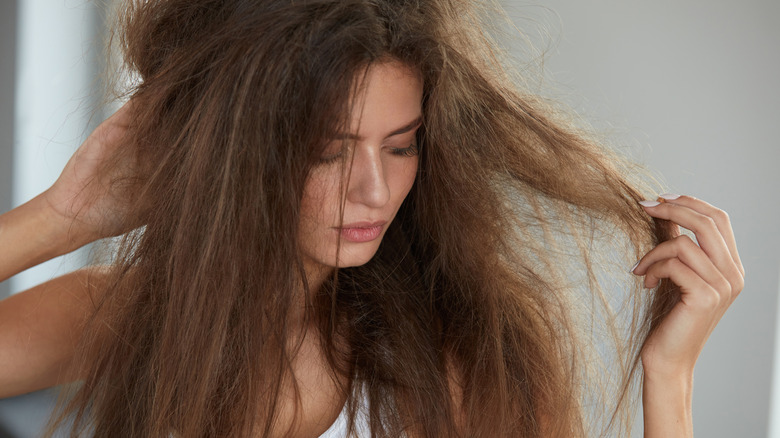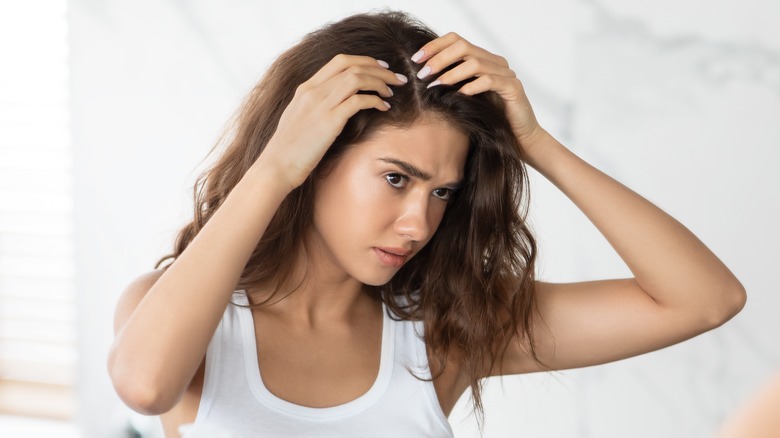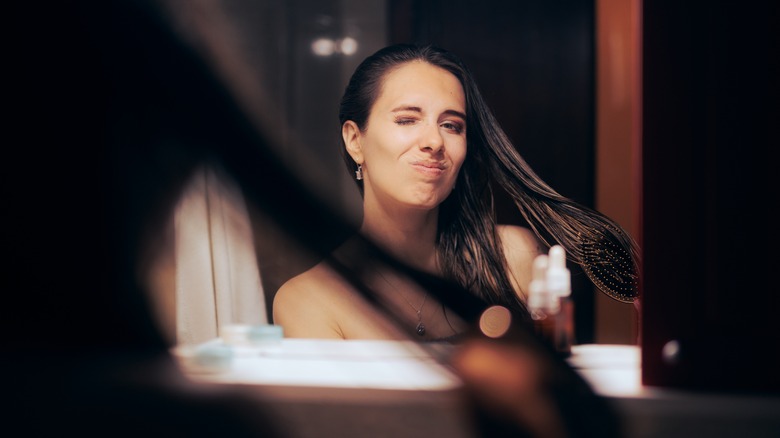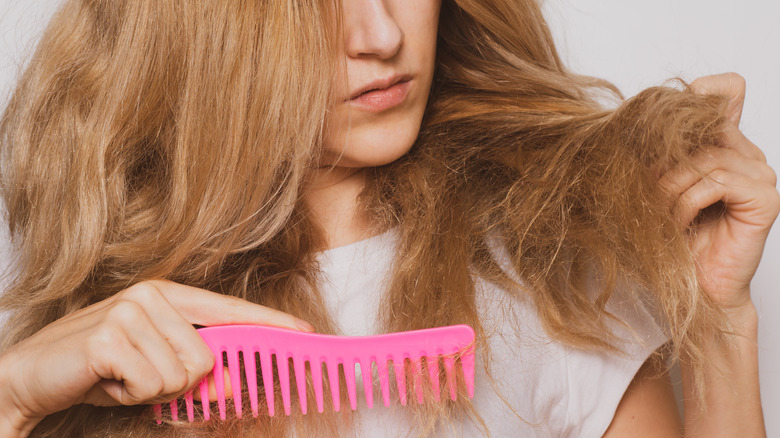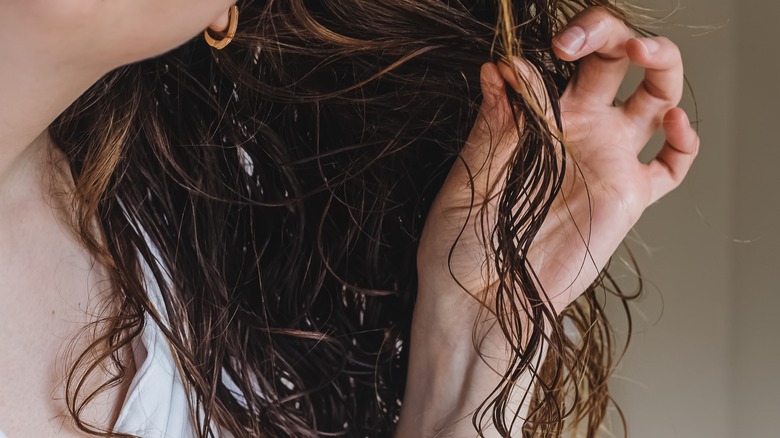10 Telltale Signs You're Dealing With Hair Damage
With all the social media photo opportunities we're facing these days (paging Facebook, Instagram, and TikTok), more and more people are feeling the need to look picture-perfect pretty much all the time. A big part of always looking our best involves keeping up with our hair routines, which means dyeing, straightening, curling, and pretty much everything in between almost on a daily basis. But all that work on our hair comes at a price. A 2013 study from Head and Shoulders actually found that a massive 91% of women in the U.S. did something to their locks every single day that could potentially cause damage. Not only do super hot hair tools and dyes cause our hair serious harm, but things like brushing it when it's wet, chemical treatments, having super tight ponytails, not using heat protectant, installing hair extensions, and even just exposing your hair to the sun can all also be bad for its health.
But how do you actually know if your hair is damaged and how badly it's been affected? Well, there are a few tell-tale signs when it comes to what you need to look out for, and Women.com is breaking them all down for you — pun intended.
A lack of elasticity
One of the best signs your hair has been damaged is noticing a distinct lack of elasticity. The best way to check your hair's elasticity is to take a strand in between your fingers and give it a (gentle) pull. If your hair stretches a little, around 30%, then it's probably healthy. If it stretches any more than that or breaks off or snaps off in your hand, then it's been damaged.
One of the main things that can strip your hair of its bounce is repeated dyeing. For those who regularly have their hair colored (consider us guilty!) the process will keep opening and closing the hair shaft's cuticle every time you put the product onto your locks. That has an effect on the hair's bonds, which means, structurally, your hair is left weak and brittle. Once this happens, it can be difficult for the hair to recover, and your best bet is to cut off the weak strands and start again.
That certainly doesn't mean you shouldn't dye your locks if that's what you want to do, though we'd recommend leaving as long as you can in between salon sessions, trying more natural dyes, or only dyeing the roots on a regular basis. You may also want to opt for semi-permanent dyes over permanent ones, as the former is less likely to cause damage. It's ammonia-free, so it tends to stay on the outside of the hair's strands and doesn't permeate its membrane.
The dreaded split ends
One of the most common signs of damaged hair is split ends (also known in medical terms as trichoptilosis), which means the ends of your hair literally split open. "These changes occur in the ends of hair shafts as a result of dryness, heat damage, or chemical irritation. This may occur as a result of using hair ties that are abrasive, brushes with firm, inflexible fibers, overheating the hair from a hair dryer, straightener, or curler, damage from dyes or other chemicals, and alteration of the hair cuticles from excessive washing," Shari Sperling explained to Byrdie.
There are a number of different types of split ends you might see. If your hair isn't totally damaged, you might notice a small Y-shaped version of a split end, which means you could potentially still repair the split using things like nourishing hair masks and cutting down on your use of hot hair tools. Another type of slightly less serious split ends will look like a larger Y, which means the cortical cells have now been exposed. On the opposite end of the spectrum are either tree or fork splits, which look exactly like their names. Both of these types of split ends mean your hair is, unfortunately, pretty darn damaged and we'd recommend a trip to the salon to have them chopped off and to get some advice on how to keep your hair healthier going forward.
Easily broken strands
You may not necessarily have split ends, but your locks could still be showing signs of breakage without becoming separated from the ends. Though it usually happens closer to the ends because of how long they've been around and all the heat and other factors they've been exposed to over that time, damaged hair can actually start from anywhere along the strands. The way you'll likely notice it is by a section of the hair strand literally coming apart, or by part of the hair literally dangling off. A great way to look out for breakage is by keeping a closer eye on what happens when you're interacting with your locks. "Look for more hair lost in the shower or visible on your brush or pillow because it's more sensitive to breakage," Mathilde Sitter, Prose R&D Project Leader, suggested to Prose. You may also notice more hair getting attached to your clothing or more hair coming off in your hands when you put your hair into a ponytail or style it.
"If you're noticing breakage throughout your hair, you're probably experiencing over processing from a color service or a chemical treatment," revealed Laavoo Hair in a chat with celebrity stylist Graham Nation. Make sure your hair is well-prepared for a color treatment by treating it to a hair mask before you head to the salon in order to help it retain moisture.
Bubble hair
Bubble hair is the term used to refer to hair that's been damaged by excessive exposure to heat while it's still wet. The heat and water mix together to essentially boil the hair, with the water inside the strands turning into steam that then gets trapped. To make room for the steam, the hair expands and creates somewhat of an air bubble inside itself. The result is seriously weak hair that breaks off and becomes stiff, frizzy, and full of texture — just not in a good way. You'll probably notice the most damage at the ends, as that part has been around the longest to have received the most harm, with the proof coming from straw-like ends that break off. "Never blow-dry hair that hasn't been towel- or air-dried partially first or use styling irons on hair that's not totally dry, as that can cause any water inside to boil and the strand to rupture," GH Beauty Lab senior chemist Sabina Wizemann recommended to Good Housekeeping.
You can sometimes also get an effect like this if you brush your hair when it's wet and at its most susceptible to damage. "Water exposure swells and stretches the hair's shaft, which causes the shingle-like outer layer to lift, and adding stress from brushing in that state can cause it to break," Wizemann shared. To avoid causing more issues, it's best to comb your hair when it's wet or use a specific tool made to detangle long or wet locks.
Thinner looking locks that feel thick at the route but thin at the ends
Though a lot of thinning hair is caused by a number of different things, including alopecia, illness, childbirth, or a hormonal imbalance, it is possible for your hair to appear thinner because it's so damaged. One of the things you may notice is that where your new hair is growing through at the roots, it's thick and healthy, but the bottom feels thin and sparse. "This can often be a result of blow-drying or hot iron tools," stylist for Sharon Dorram Color at Sally Hershberger told Real Simple of this phenomenon.
Things like excessive split ends will, of course, make your hair look less thick because each strand is literally made thinner as the split ends peel off. Weaker strands caused by things like too much heat are also more likely to snap off in time, which could result in you having the same amount of hair protruding from the scalp, but a lot less healthy bulk down at the ends. Some hair extensions, depending on how they're attached to your head, can also cause impairment to the hair and can pull out your natural strands at the same time, which may be another reason your damaged hair is looking so thin.
Too much frizz
Though a lot of people have naturally frizzy hair, if you naturally have smoother locks that you now can't seem to tame, that may be a sign your locks have been injured. You may notice this by your hair suddenly having a lot more volume than it usually does, as frizzy, broken hair will make the overall look of your hair a lot bigger — but not in a way you'll want it to. Frizz can also be a side effect of split ends, as they weaken the hair, which leaves it even more vulnerable to breakages, and is particularly caused by too much exposure to heat or a lack of moisturizing hair products in your routine. "[Frizz] could be caused by dryness from weather, over-shampooing or shampooing the ends of your hair," Graham Nation further explained to Byrdie.
Though, we're sorry to say, chopping off damaged hair is the only real way to permanently improve frizzy hair, you could also use a leave-in conditioner in an attempt to add a little moisture back into your tresses and try and tame unruly frizz. "The right leave-in conditioner will help to moisturize and repair your hair," celebrity colorist and extension expert at Benjamin Salon, Meri Kate O'Connor, explained to Ipsy, which should bring a little smoothness back to your tresses.
Frustrating flyaways
If your scalp appears to have a lot of shorter hairs that stick straight up instead of falling down as they naturally should, it may be that these little strands were once longer, healthier hairs but have become shorter because the ends have broken off. A lot of the time, you can tell you have damaged flyaways because you'll struggle to style or tame the short hairs, even with a heat tool, and you'll probably notice they don't have the same weight or thickness as the rest of your tresses.
One of the most common reasons flyaways pop up (literally) is from repeatedly putting a lot of heat on them. Things like hair dryers, curlers, and straighteners can be the worst culprits because of the way they strip the moisture and leave the cuticles susceptible to damage. One way you can help prevent this is by getting your hands on bond building treatments to nourish the hair and encourage each strand to get tougher to resist breakages. "These products are great to help repair hair by filling in the cuticle to create a stronger bond," Meri Kate O'Connor shared while chatting to Ipsy.
Dull hair could mean damaged cuticles
If your hair is missing its brightness and shine, that may be a pretty good indication that it's suffered some damage. It's actually the cuticles in the hair that make it appear shiny, so when the cuticles have been compromised, it can make your tresses look extremely flat in terms of color. Dryness can also cause the same effect, because it suggests your hair isn't maintaining moisture in the way it should be to bring the brightness. Not only will that cause dull hair, but it can have an extra side effect too in that dryness can make your locks extra susceptible to breakages.
This can become more obvious if you've dyed your hair and you're still not getting the color you wanted, as hair that's been harmed by a lot of heat is unable to retain color in the same way healthy hair can due to it getting too porous. Usually what will happen is your tresses will be darker than you actually want them to be, because the strands will soak up too much of the dye. You'll probably find that it then doesn't hold the color for too long either, as the porous strands can't retain the dye as long.
Tough tangles
There's a reason the movie "Tangled" was called just that, because we're sure Rapunzel had to have a ton of tangles in her hair with those crazy long locks. It's also one of the ways you can tell if your tresses have suffered damage, as damaged hair is much more likely to get knotted. The reason why is that our hair cuticles should ideally lay flat and together when our hair is in good condition, but when it isn't, the cuticles can start to sit out of place — which creates the messy mass of hair so many of us can encounter when brushing our locks. The worst part is, the more knots your hair gets, the more you have to try and brush or comb them out, which usually only ends up causing more damage.
Of course, knots don't always happen just because your hair's damaged. Odd tangles can just be the result of something like trying out a new hairstyle or being out in the wind without a brush, but if it's happening regularly, particularly when combined with the other tell-tale signs on our list, it's more than likely your hair's damaged. The best way to fight this is by ensuring your hair locks in more moisture via things like moisturizing shampoos and conditioners, as well as using a detangling spray to tame those knots. "A moisturizing leave-in treatment is a good option for hair that is tangling," Gretchen Friese, certified trichologist for BosleyMD, told Byrdie.
Stiff hair is probably damaged hair
One of the easiest ways to see if your hair is damaged or not is to literally touch it and feel for yourself. You'll be able to tell pretty quickly if it's not in its best state by the texture, particularly if it's wet. "Over-exposure to the elements such as sun, salt water and chlorine can make your hair almost feel crunchy when it's wet and appear dry and brittle on the ends after it is styled," hairstylist Tim Lehman explained while speaking to Real Simple.
If you touch your wet hair and it feels like it's become stiff or crunchy, or it even breaks right off in your hand, then you know you're dealing with some damaged tresses. As for how you can rectify this? "The best remedy might be to get a good trim with your stylist, or try a treatment mask for your hair," Lehman said.
